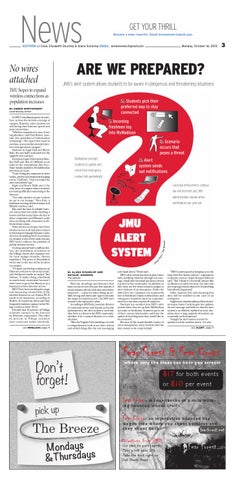News
Get your thrill Become a news reporter. Email breezenews@gmail.com.
Monday, October 14, 2013
Editors IJ Chan, Elizabeth Dsurney & Alana Scharlop Email breezenews@gmail.com
No wires attached JMU hopes to expand wireless connections as population increases
3
ARE WE PREPARED? JMU’s alert system allows students to be aware in dangerous and threatening situations
By Amber Montgomery contributing writer
As JMU’s enrollment grows in numbers, so does the wireless coverage of campus. However, some students are still facing slow Internet speed and poor connections. “Wireless expansion is one of our top priorities,” said Dale Hulvey, assistant vice president of information technology. “We expect this trend to continue as we provide extended wireless coverage across campus.” Students in Eagle Hall and Shorts Hall, the two halls evaluated for the upgrade next summer. Freshman Eagle Hall resident Monika Chill said that it’s difficult to do tasks on her smartphone, like FaceTime family members. Portability has also been an issue. “I can’t bring my computer to other rooms, which I am frequently hanging out in,” Chill said. “I have to adjust the wire everywhere I go.” Eagle and Shorts Halls aren’t the only areas of campus where students are having difficulty connecting to the Internet. “The only wireless we get is when we go to our lounge,” Nora Kim, a freshman nursing declared major and Hillside resident, said. Kim said the lack of reliable Internet connection has made studying a hassle and that many times she has to share computers and Ethernet cords when studying with classmates in different dorm rooms. Other dorms on campus don’t have wireless access at all and must connect to the Internet through Ethernet cords. The cost of installing Wi-Fi everywhere on campus is one of the main reasons JMU hasn’t address the problem of patchy wireless service. Costing around half a million dollars, the installation of wireless in the Village dorms this summer was far from budget-friendly, Hulvey explained. The price of installation varies due to the size of the location on campus. “It’s great not having to plug up an Ethernet cord just to check my email,” said freshman studio art major, Tori Jackson. “It makes doing schoolwork so much more convenient because I don’t have to go to the library or to a basement to have Internet access.” JMU IT has been tracking the usage and measuring connectivity of the wireless Internet to see if more Wi-Fi needs to be improved, according to Hulvey. It’s based on when and how frequently students connect to the Village residence halls’ Wi-Fi. It found that 38 percent of Village residents connect to the Internet by Ethernet connection. The other 62 percent of Village residents have connected online wirelessly. see Wireless, page 4
MyMadison prompts students to update and check their emergency contact info periodically Local law enforcement, campus law enforcement and JMU administrators decide when notifications are sent out
By Alana Scharlop and Natalie Johnson The Breeze
With the shootings and disasters that have occurred over the past few months it seems citizens all over wish they were better prepared — a plan for when things go terribly wrong and when safe spaces become the target for malicious acts. The JMU alert system is the university’s plan. According to Bill Wyatt, associate director of communications and deputy university spokesperson, the alert system is used any time there is a threat to the JMU community, whether it be a natural disaster or a crisis situation. “After the Virginia Tech shootings, we took a comprehensive look at our alert system and added things like the text messaging
and email alerts,” Wyatt said. JMU’s alert system has been in place since 2007, notifying students through text message, email and voicemail any time a threat is posed to the community. In addition to this, there are five sirens around campus to alert students of an emergency. Under the 1990 Clery Act, campuses are required by law to distribute timely notifications and emergency situations must be communicated in a way that reaches all students. Students are enrolled into JMU’s alert system when they set up their MyMadison accounts as freshmen. Students put in all of their contact information and have the option of deciding how they would like to be contacted. Because of the unpredictable nature of most emergencies, some students find the alert system to be a step behind.
“JMU is pretty good at keeping us in the loop with the timely notices,” sophomore computer science major Keegan Sullivan said. “But I think it’s honestly almost like an illusion of safety because the only way you’re going to know about it is if something bad already happened.” Other students feel safer knowing that they will be notified in the case of an emergency. Sophomore interdisciplinary liberal studies major Annie Cochran gets her updates via text message and believes that the alert system is an efficient method in most situations since a large majority of students are constantly on their phones. Though the alert system is most frequently used for weather alerts, it is also see Alert, page 4
Fear Forest & Fear Crops where only the trees can hear you scream
Visit:
$17 for both events or $10 per event
Fear Forest- A four tenths of a mile walking haunted woods trail
Fear Crops- an interavtive haunted hay
wagon ride where you shoot zombies and they shoot back fearforest.net
Directions from JMU:
-Go east on port republic -Take a left onto 276 -Take the first right on Oak Shade Road
